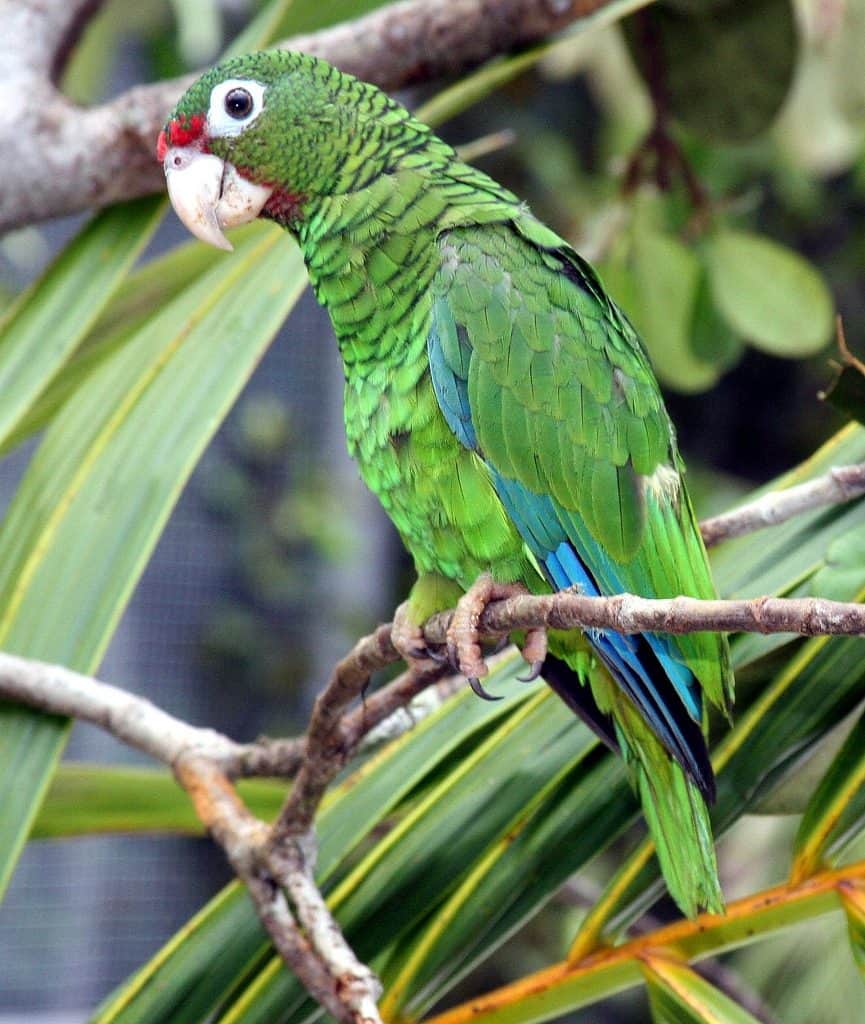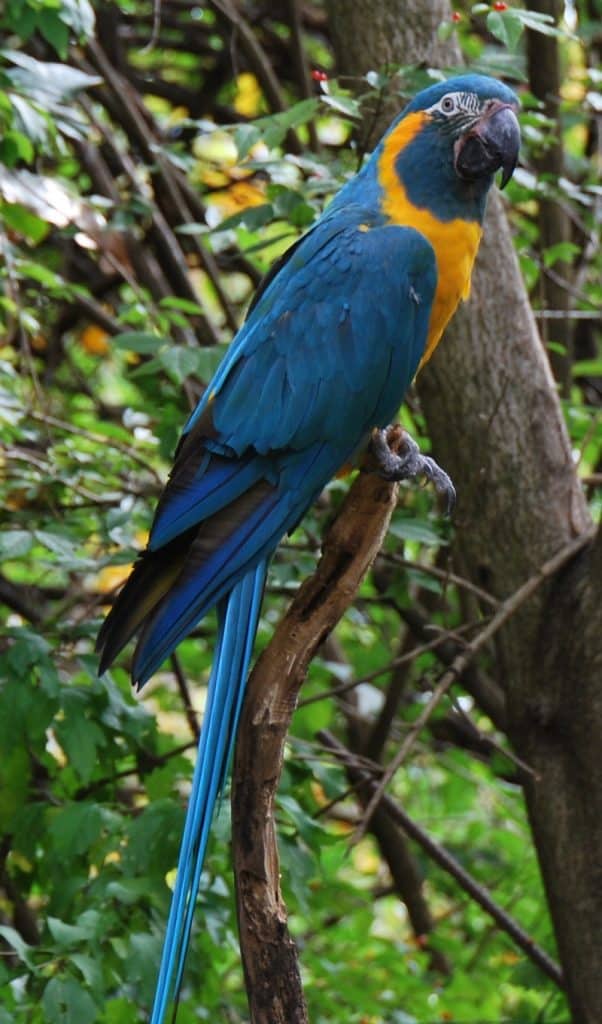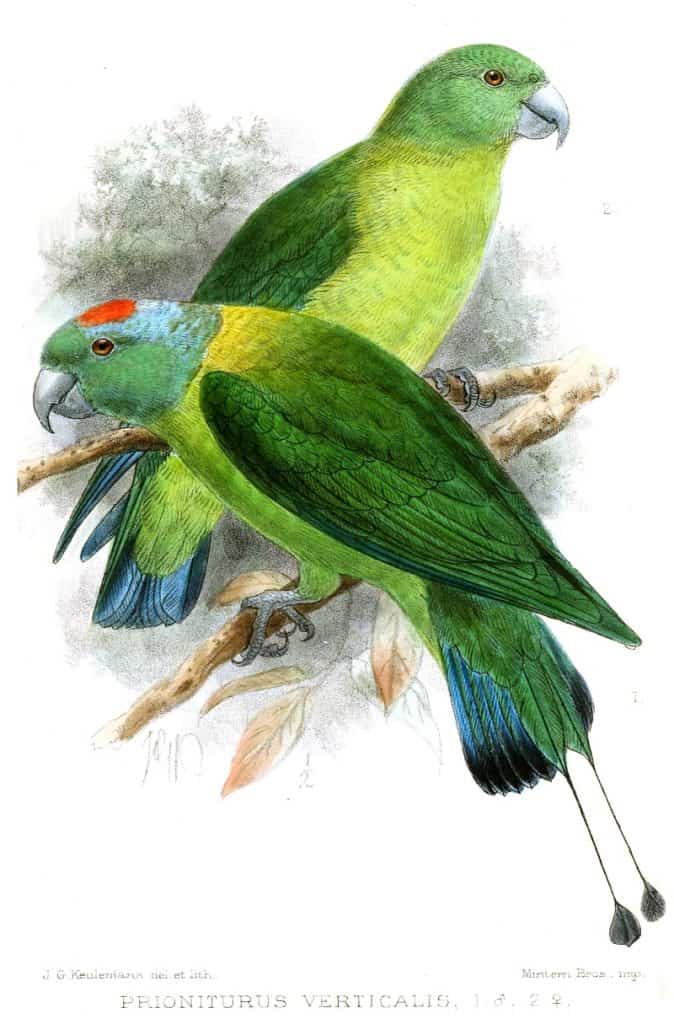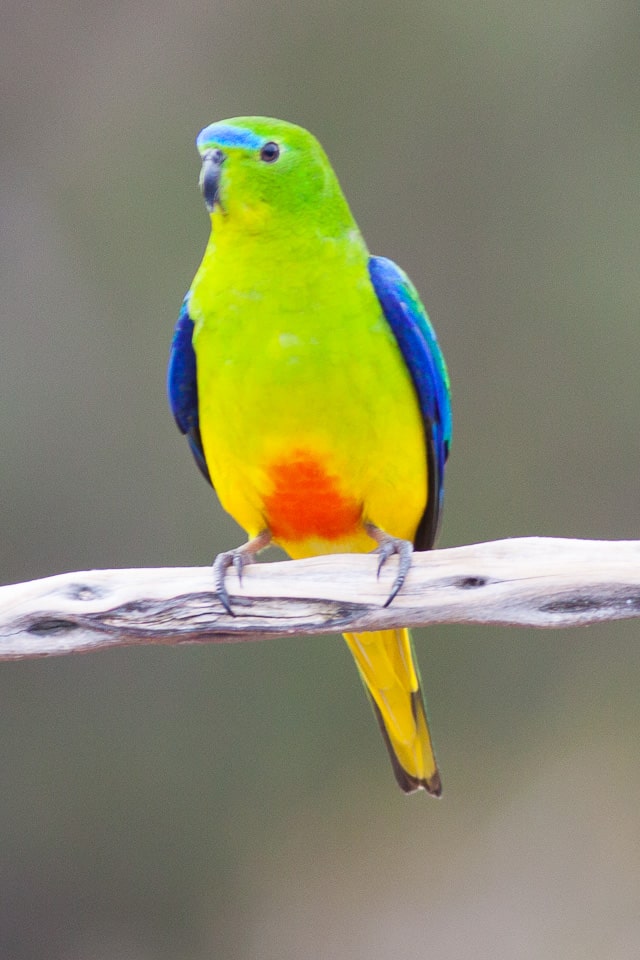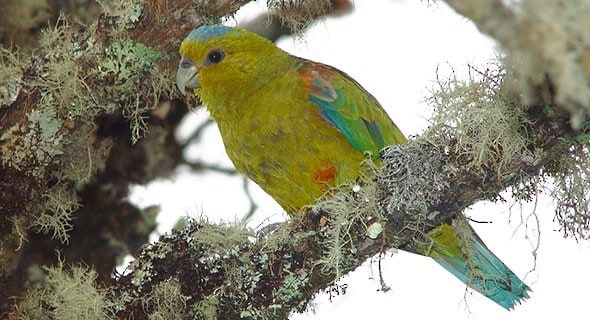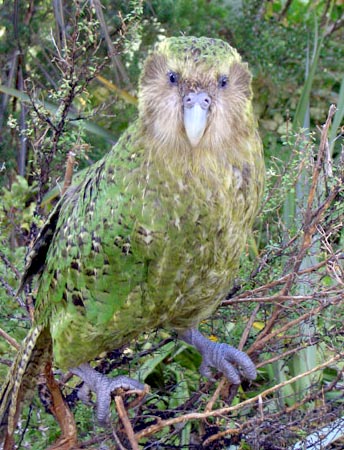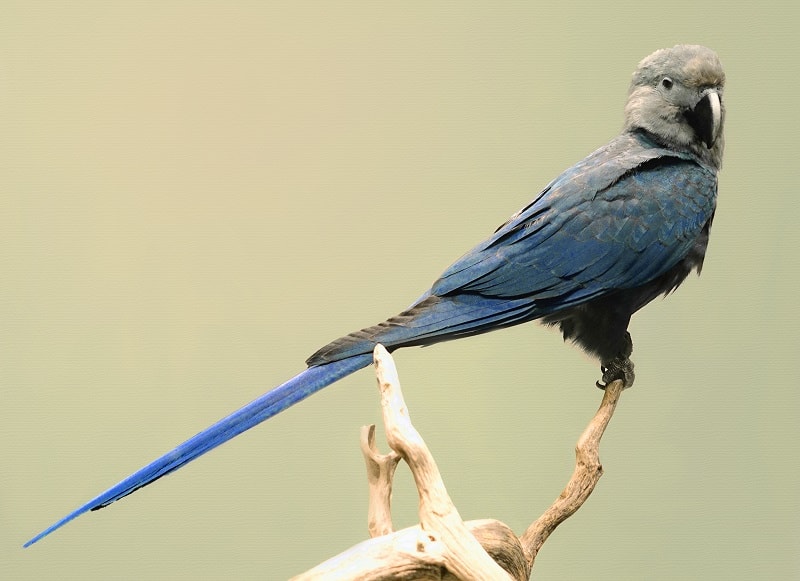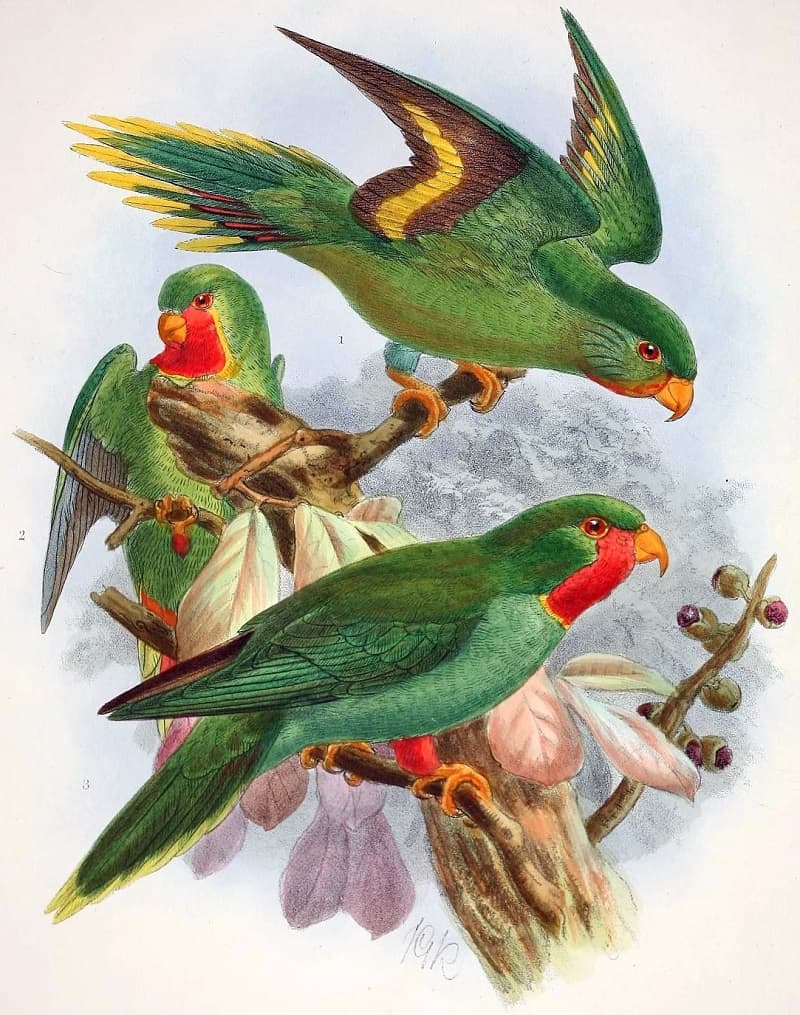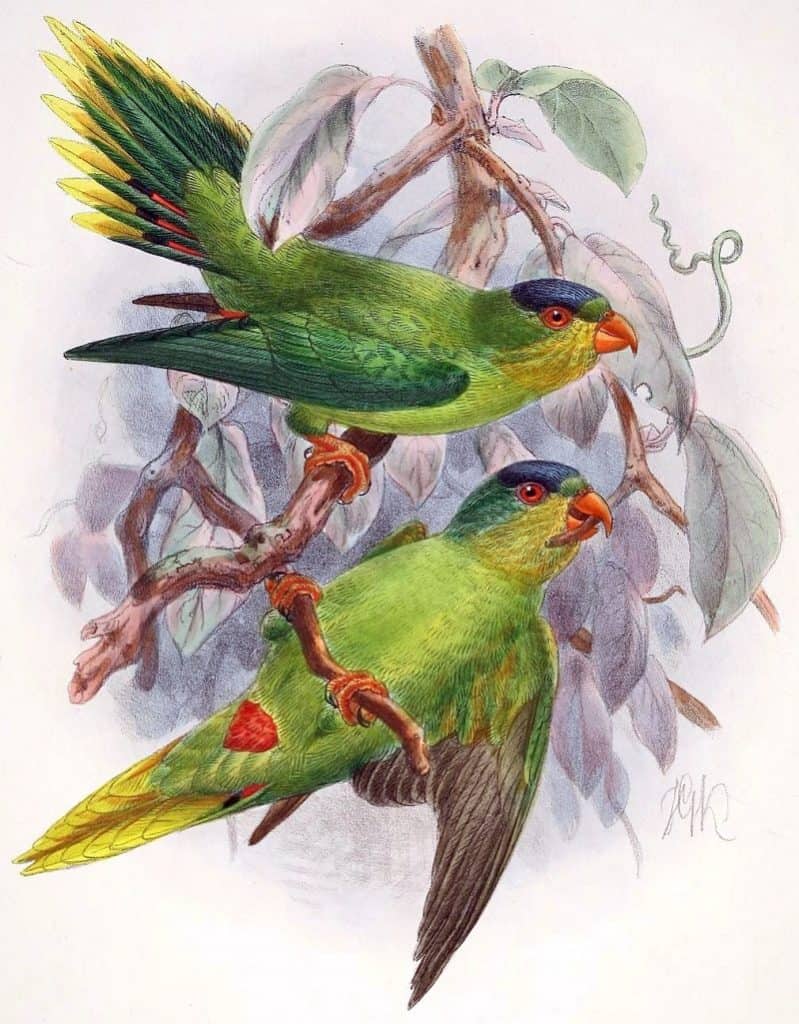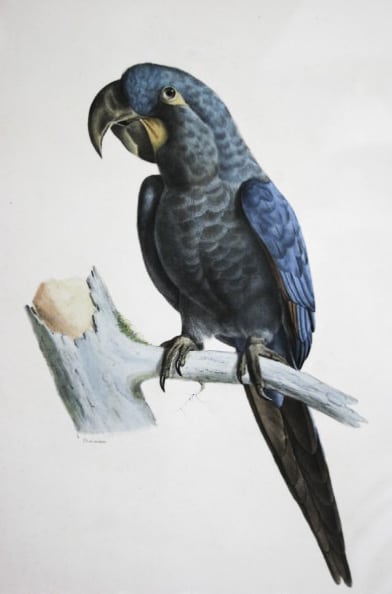Parrots are some of the most colorful, unique, and interesting birds in the world. In popular culture, parrots have become known for their ability to speak like humans or replicate sounds. They also know how to sing and can even be taught to dance. Unfortunately, all of these positive traits have made parrots too popular. Several species are now endangered because of illegal poaching.
In fact, most of the rare parrots on this list are critically endangered because they are taken from the wild and sold as pets and because their habitats are being deforested. Fortunately, efforts are being made to curtail the illegal selling of wild parrots. Researchers hope to develop methods to test whether or not a parrot came for the wild or was bred in captivity.
- Puerto Rican Amazon
- Blue-throated Macaw
- Sulu Racquet-tail
- Orange-bellied Parrot
- Indigo-winged Parrot
- Kākāpō
- Spix’s Macaw
- Red-throated Lorikeet
- New Caledonian Lorikeet
- Glaucous Macaw
Country of Origin: El Yunque National Forest, Rio Abajo State Forest, Maricao Commonwealth Forest in Puerto Rico
Scientific Name: Amazona vittata
Conservation Status: Critically Endangered

photo source: Flickr via vivtony00
The Puerto Rican Amazon, also called the Puerto Rican parrot and Iguaca, is a rare parrot native to Puerto Rico. Like most of the parrots on this list, the Puerto Rican Amazon is critically endangered in the wild and there are anywhere from 50 – 100 wild Puerto Rican Amazons remaining.
Fortunately, there are numerous conservation efforts going on to save the Puerto Rican Amazon. Conservationists have successfully reintroduced several Puerto Rican Amazaon in the wild and have established new population sites. Recently, the U.S. Fish and Wildlife Service has renewed its commitment to conserving the Puerto Rican Amazon. This good news comes just a year after Hurricane Irma and Maria devastated Puerto Rico and damaged a few breeding facilities. All 400 or so captive Puerto Rican Amazons were unharmed, but all of the wild parrots at El Yunque National Forest have disappeared.
Country of Origin: Los Llanos de Moxos, Bolivia
Scientific Name: Ara glaucogularis
Conservation Status: Critically Endangered

photo source: Flickr via Ted
The beautifully blue and yellow toned Blue-throated Macaw is a rare parrot from Bolivia. It is estimated that there are about 250 – 300 Blue-throated Macaws remaining in the wild. The Blue-throated Macaw population has been decimated because of illegal catching and selling of the birds as pets. Their natural habitat has also been cleared to make way for private cattle ranches.
Unlike some of the other rare parrots on this list, things are looking up for the Blue-throated Macaw. Strong conservation efforts have helped the Blue-throated Macaw bounce back. In April 2018, it was reported that about 155 Blue-throated Macaws were spotted in the Los Llanos de Moxos. These Blue-throated Macaws are descended from the parrots raised in captivity that were released back into the wild. Conservationists plan to expand their efforts and acquire more protected land for the Blue-throated Macaw to live in.
Country of Origin: Tawi-Tawi Island, Philippines
Scientific Name: Prioniturus verticalis
Conservation Status: Critically Endangered

photo source: Wikimedia Commons (Artwork by John Gerard Keulemans)
The Sulu Racquet-tail is a rare parrot native to the Sulu archipelago in the Philippines. In the past, it was estimated that there were around 1,000 Sulu Racquet-tails in the wild, but recent observations suggest that there may be fewer than 250 mature parrots left. This puts the total population of Sulu Racquet-tails between 75 – 375 individuals.
At its height, the Sulu Racquet-tail was found on six islands and was locally abundant. However, by the 1970s, the population of Sulu Racquet-tails took a sharp decline as the primary forests on the islands have been cleared. The small number of remaining Sulu Racquet-tails are confined to Tawi-Tawi island, but the parrot’s last few habitats are being deforested by logging.
Country of Origin: Melaleuca, Tasmania, Australia
Scientific Name: Neophema chrysogaster
Conservation Status: Critically Endangered

photo source: Flickr via Ron Knight
The aptly named and cute little Orange-bellied Parrot is critically endangered in its natural habitat Melaleuca, Tasmania, Australia. According to the IUCN Red List and other researchers, there may be fewer than 50 Orange-bellied Parrots left in the wild.
While the number of Orange-bellied Parrots may be dwindling in the wild, there is an extensive breeding program that has a few hundred parrots in captivity. During the last update from 2012, there were about 208 Orange-bellied Parrots in captivity with the goal of reaching 350 by 2016/2017. In early 2018, conservationists announced that they were collecting juvenile Orange-bellied Parrots and keeping them safe until they are ready to be released back into the wild for breeding season.
Country of Origin: Central Andes of Colombia
Scientific Name: Hapalopsittaca fuertesi
Conservation Status: Critically Endangered

photo source: neotropical.birds.cornell.edu
The Indigo-winged Parrot or Fuertes’s Parrot is a critically endangered bird whose numbers have somewhat stabilized through conservation efforts. However, the IUCN Red List estimates that there may only be around 160 Indigo-winged Parrots left in the wild. This rare parrot has a very restricted range on the west slope of the Central Andes of Colombia.
For about 90 years, scientists believed that the Indigo-winged Parrot had gone extinct, but about a dozen birds were discovered by ProAves biologists in 2002. The area that the parrots were found in has become the Giles–Fuertesi Nature Reserve. Through conservation efforts, the number of Indigo-winged Parrots was brought up to 250 in 2012. Despite being protected, the Indigo-winged Parrot is still threatened because its habitat is negatively impacted by nearby deforestation as well as potential gold mining.
Country of Origin: North, South, and Stewart Islands of New Zealand
Scientific Name: Strigops habroptila
Conservation Status: Critically Endangered

photo source: Flickr via New Zealand Department of Conservation
The Kākāpō is relatively unknown compared to its much more famous fellow flightless bird from New Zealand, the Kiwi. The rarity and critically endangered status of the Kākāpō are a large reason why many people don’t know about this parrot. According to the New Zealand Department of Conservation, there are only 148 Kākāpō alive today.
The Department of Conservation has been working hard to ensure that the Kākāpō species survives. The most famous Kākāpō, who is named Sirocco, has become the mascot of the Kākāpō conservation movement. People can also symbolically adopt a Kākāpō on the Department of Conservation’s website. The adoption fees go toward Kākāpō health management, supplementary food, and annual transmitter changes.
Country of Origin: North, North Bahia, Brazil (near the São Francisco river)
Scientific Name: Cyanopsitta spixii
Conservation Status: Extinct in the Wild (EW)

photo source: Wikimedia Commons via Daderot
The Spix’s Macaw, which famously inspired the animated movie Rio, was one of eight bird species recently declared extinct in the wild in September 2018. The good news is that there are about 60 to 80 birds in captivity as part of breeding programs. Over the years, there have been reported local sightings of the Spix’s Macaw in the wild, but it is believed that these birds escaped from captivity.
According to scientists, half of the now extinct in the wild bird species are from Brazil. The declining number of Spix’s Macaws is largely due to deforestation. Researchers are worried because this is the first time that extinctions on Brazil’s mainland are outpacing the extinctions that typically occur on the country’s islands.
Country of Origin: Islands of Viti Levu, Vanua Levu, Taveuni, and Ovalau, Fiji
Scientific Name: Charmosyna amabilis
Conservation Status: Critically Endangered (CR)

photo source: Wikimedia Commons (Artwork by John Gerard Keulemans)
The Red-throated Lorikeet is yet another parrot whose status in the wild is unknown. For right now, the IUCN Red List considers the Red-throated Lorikeet to be critically endangered, but not yet extinct because there have been reported sightings from time to time by locals. The Red-throated Lorikeet is native to several islands in Fiji.
There have been several survey teams sent out to track down the Red-throated Lorikeet, but all of them have been unsuccessful. Logging and road construction has caused habitat loss and the Red-throated Lorikeet has been harder to find in recent years than it already was.
Country of Origin: Island of Malesia, New Caledonia
Scientific Name: Charmosyna diadema
Conservation Status: Critically Endangered

photo source: Wikimedia Commons (Artwork by John Gerard Keulemans)
Like the Glaucous Macaw, the current status of the New Caledonian Lorikeet is completely unknown. The New Caledonian Lorikeet has not been seen since 1976 despite numerous efforts over the years to search for the parrot. Research teams were sent out in 2002 and 2011 to try and locate the New Caledonian Lorikeet and unfortunately, the elusive parrot still has not been found.
Researchers advise that the New Caledonian Lorikeet’s status be updated to Critically Endangered – Possibly Extinct because there are no signs of the bird in the wild. The New Caledonian Lorikeet has always been considered rare because the species is only known from a few specimens collected in 1859 and another from 1913. Due to this, the New Caledonian Lorikeet is tied with the Glaucous Macaw as the rarest parrot in the world.
Country of Origin: north Argentina; south Paraguay; northeast Uruguay; and Brazil
Scientific Name: Anodorhynchus glaucus
Conservation Status: Critically Endangered (CR)

photo source: Wikimedia Commons via Bourjot Saint-Hilaire
Not much is known about the current state of the Glaucous Macaw population in the wild. The IUCN Red List estimates that there are fewer than 50 Glaucous Macaws in the wild, but there have been no confirmed sightings since the 1960s. Additionally, a recent report suggests that the Glaucous Macaw be reclassified as Critically Endangered – Possibly Extinct due to no sign of the bird in recent years.
With no information about how many Glaucous Macaws are left and from our research there doesn’t appear to be any Glaucous Macaws in captivity. Unlike some of the other parrots on this list, there is no news regarding any breeding programs for the Glaucous Macaw. All of this makes the Glaucous Macaw the rarest parrot in the world.

